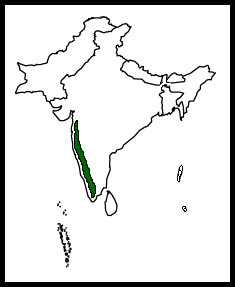Alternative name: Blue-winged Parakeet
- Psittacula columboides
Identification
36–38 cm (14¼-15 in); a medium sized blue-greenish Parakeet
- Very long tail
- Blue-grey foreparts
- Black collar
- Blue rump and primaries
- Yellow edges on dark wing coverts
Male
- Blue lower border to collar
- Red upper mandible
Female
- Duller and greener than male
- All black bill
Distribution
| Endemic to Western Ghats south from N Maharashtra in Southern India. Can be found in various National Parks and reserves such as Nagarhole, Mudumalai, Periyar and Thattekad Bird Sanctuary.
A locally common restricted range species. | |
| Legend |
Taxonomy
A monotypic member of the S Asian Psittacula Parakeets[6].
Habitat
Tropical evergreen forest, moist deciduous forest, secondary growth and abandonend plantations. From the plains up to 1600m, but mainly between 450-1000m.
Seems to be able to adapt also to disturbed habitats.
Behaviour
A gregarious species which sometimes forms mixed flocks with Plum-headed Parakeets.
Breeding
Breeds from December to March. Nests in a tree hole, preferring high trees, usually Ironwood and Grewia tiliifolia. Lays 4-5 eggs.
Diet
Feeds on grain, seeds and fruits (preferring figs). Takes also buds, petals and nectar. May damage crop of Sorghum or other cereals and Orchards.
Movements
Resident with some food-related movements.
References
- Rasmussen, PC and JC Anderton. 2005. Birds of South Asia: The Ripley Guide. Barcelona: Lynx Edicions. ISBN 978-8487334672
- Grimmett, R, C Inskipp, and T Inskipp. 1998. Birds of the Indian Subcontinent. London: Christopher Helm. ISBN 978-0713640045
- Kazmierczak, K and B van Perlo. 2000. A Field Guide to the Birds of the Indian Subcontinent. New Haven: Yale Univ. Press. ISBN 978-0300079210
- Kazmierczak, K and R Singh. 2001. A Birdwatcher's Guide to India. New Dehli: India Oxford Univ. Press. ISBN 978-1871104080
- Del Hoyo, J, A Elliot, and J Sargatal, eds. 1997. Handbook of the Birds of the World. Volume 4: Sandgrouse to Cuckoos. Barcelona: Lynx Edicions. ISBN 978-8487334221
- Clements, J. F., T. S. Schulenberg, M. J. Iliff, D. Roberson, T. A. Fredericks, B. L. Sullivan, and C. L. Wood. 2017. The eBird/Clements checklist of birds of the world: v2017, with updates to August 2017. Downloaded from http://www.birds.cornell.edu/clementschecklist/download/
Recommended Citation
- BirdForum Opus contributors. (2024) Malabar Parakeet. In: BirdForum, the forum for wild birds and birding. Retrieved 6 May 2024 from https://www.birdforum.net/opus/Malabar_Parakeet
External Links
Search the Gallery using the scientific name:
Search the Gallery using the common name:
GSearch checked for 2020 platform.







